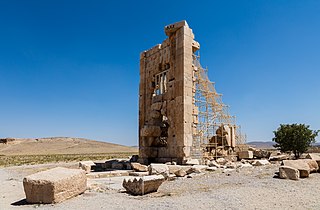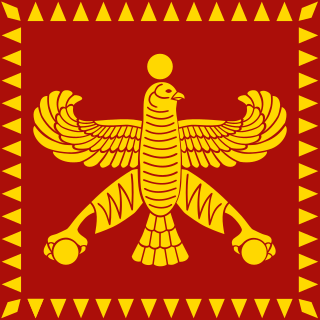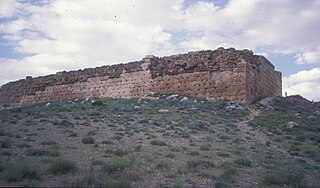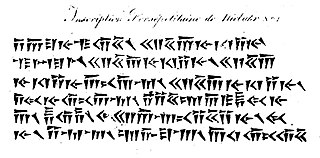
The Behistun Inscription is a multilingual Achaemenid royal inscription and large rock relief on a cliff at Mount Behistun in the Kermanshah Province of Iran, near the city of Kermanshah in western Iran, established by Darius the Great. It was important to the decipherment of cuneiform, as it is the longest known trilingual cuneiform inscription, written in Old Persian, Elamite, and Babylonian.
The year 640 BC was a year of the pre-Julian Roman calendar. In the Roman Empire, it was known as year 114 Ab urbe condita. The denomination 640 BC for this year has been used since the early medieval period, when the Anno Domini calendar era became the prevalent method in Europe for naming years.

Cambyses I was king of Anshan from c. 580 to 559 BC and the father of Cyrus the Great (Cyrus II), younger son of Cyrus I, and brother of Arukku. He should not be confused with his better-known grandson Cambyses II.

Cyrus I or Cyrus I of Anshan or Cyrus I of Persia, was King of Anshan in Persia from c. 600 to 580 BC or, according to others, from c. 652 to 600 BC. Cyrus I of Anshan is the grandfather of Cyrus the Great, also known as Cyrus II. His name in Modern Persian is کوروش, Kūroš, while in Greek he was called Κῦρος, Kȳros.

Cyrus II of Persia, commonly known as Cyrus the Great, was the founder of the Persian Achaemenid Empire. Hailing from Persis, he brought the Achaemenid dynasty to power by defeating the Median Empire and embracing all of the previous civilized states of the ancient Near East, expanding vastly and eventually conquering most of West Asia and much of Central Asia to create what would soon become the largest polity in human history at the time. The Achaemenid Empire's largest territorial extent was achieved under Darius the Great, whose rule stretched from Southeast Europe in the west to the Indus River valley in the east.

Anshan modern Tall-e Malyan, also Tall-i Malyan, was an Elamite and ancient Persian city. It was located in the Zagros Mountains in southwestern Iran, approximately 46 kilometres (29 mi) north of Shiraz and 43 kilometres (27 mi) west of Persepolis in the Beyza/Ramjerd plain, in the province of Fars.

Teïspes ruled Anshan in 675–640 BC. He was the son of Achaemenes of Persis and an ancestor of Cyrus the Great. There is evidence that Cyrus I and Ariaramnes were both his sons. Cyrus I is the grandfather of Cyrus the Great, whereas Ariaramnes is the great-grandfather of Darius the Great.

Lullubi,Lulubi, more commonly known as Lullu, were a group of Bronze Age tribes who existed and disappeared during the 3rd millennium BC, from a region known as Lulubum, now the Sharazor plain of the Zagros Mountains of modern-day Sulaymaniyah Governorate, Iraq. Lullubi was a neighbour and sometimes ally with the Hurrian Simurrum kingdom and came into conflict with the Semitic Akkadian Empire and Assyria. Frayne (1990) identified their city Lulubuna or Luluban with the region's modern town of Halabja. The language of the Lullubi is regarded as an unclassified language because it is unattested in written record. Significantly, the term Lullubi though, appears to be of Hurrian origin rather than Semitic or the yet to arrive in the region Indo-European, and the names of its known rulers have Hurrian or more rarely Semitic influence, with no trace of Indo-European influence such as Iranic or Indo-Aryan.

The Achaemenid dynasty was a royal house that ruled the Persian Empire, which eventually stretched from Egypt and Thrace in the west to Central Asia and the Indus Valley in the east.

The Awan dynasty was the first dynasty of Elam of which very little of anything is known today—appearing at the dawn of recorded history. The dynasty corresponds to the early part of the first Paleo-Elamite period ; additionally, succeeded by the Shimashki and Sukkalmah dynasties. The Elamites were likely major rivals of neighboring Sumer from remotest antiquity—they were said to have been defeated by Enmebaragesi of Kish c. 2750 BC—who is the earliest archaeologically attested king named on the Sumerian King List (SKL); moreover, by a later monarch, Eannatum of Lagash c. 2450 BC. Awan was a city-state or possibly a region of Elam whose precise location is not certain; but, it has been variously conjectured to have been within the: Ilam and/or Fars provinces of what is today known as the Islamic Republic of Iran, to the north of Susa, close to Dezful, or Godin Tepe.

The Medo-Persian conflict was a military campaign led by the Median king Astyages against Persis in the mid 6th-century BC. Classical sources claim that Persis had been a vassal of the Median kingdom that revolted against Median rule, but this is not confirmed by contemporary evidence. After some battles the Persians led by Cyrus the Great emerged victorious, subsequently conquering Median territories and establishing the Achaemenid Empire.
The Teispids were an Iron Age branch of the Achaemenid dynasty originally ruling the southern Zagros, in ancient Anshan. The dynasty's realm was later expanded under Cyrus II, who conquered a vast area in southwestern Asia, founding what was later known as the Achaemenid Empire under Darius I. The titulary of the Teispids is recorded on the Cyrus Cylinder, in which Cyrus II identifies himself and his ancestors with the title King of Anshan, as an Elamite tradition. Teispes being the eponymous ancestor and founder, the dynasty furthermore included Cyrus I, Cambyses I, Cyrus II, Cambyses II and Bardiya.

Hystaspes or Guštāsp, was a Persian satrap of Bactria and Persis. He was the father of Darius I, king of the Achaemenid Empire, and Artabanus, who was a trusted advisor to both his brother Darius as well as Darius's son and successor, Xerxes I.

The Shimashki dynasty was an early dynasty of the ancient region of Elam, to the southeast of Babylonia,. A list of twelve kings of Shimashki is found in the Elamite king-list of Susa, which also contains a list of kings of Awan dynasty. It is uncertain how historically accurate the list is, although some of its kings can be corroborated by their appearance in the records of neighboring peoples. The dynasty corresponds to the second Paleo-Elamite period. It was followed by the Sukkalmah dynasty. Shimashki was likely near today's Masjed Soleyman.

The Sukkalmah or Epartid dynasty, was an early dynasty of West Asia in the ancient region of Elam, to the southeast of Babylonia. It corresponds to the third Paleo-Elamite period. The Sukkalmah dynasty followed the Shimashki dynasty. The title of Sukkalmah means "Grand Regent" and was used by some Elamite rulers. Numerous cuneiform documents and inscriptions remain from this period, particularly from the area of Susa, making the Sukkalmah period one of the best documented in Elamite history.
Awan was an ancient city-state or region of Elam in the western area of modern-day Iran. It often appears together with the cities of Susa and Anshan in the early history of Mesopotamia, having many conflictual interactions with Sumer.

Luh-ishan, also Luhhiššan, Luh-ishshan, Lu-ishan was a king of Elam and the 8th king of the Awan Dynasty, around 2300 BCE. He was the son of Hiship-rashini.

The Shutrukid dynasty was a dynasty of the Elamite empire, in modern Iran. Under the Shutrukids, Elam reached a height in power.

















